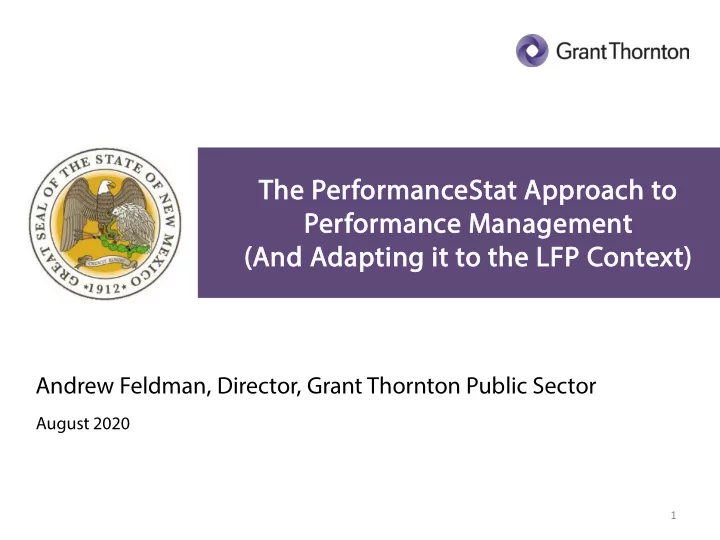

The he P Performanc rmanceStat A Approac ach h to Performanc rmance M Manage anageme ment (And d Ada daptin ing it it t to t the L LFP FP Context) Andrew Feldman, Director, Grant Thornton Public Sector August 2020 1
What i is s Per erforman manceS eStat? • Ongoing, regular meetings between leadership and agencies • Can be organized by agency or by priority areas that span agencies. (Or both.) • Participants review key trends in performance metrics, diagnose problems, and decide how to fix them. • Broader process includes prep for meetings, the meetings themselves, and follow-up actions. 2
Exampl ample: e: Gover ernor led ed StateStat in Maryland (By agency and priority) 3
Exampl ample: e: Mayor led ed LouisStat in Louisville, KY (By agency and priority) 4
Exampl ample: e: Agen ency-head ead l led ed CStat at the Colorado Dept. of Human Services (By division) 5
Approa oach ch t to c o con onside ider: Leg egisl slative-commi mmittee ee led ed 6
The d e differ eren ence b e bet etween een P Per erforman manceS eStat an and mor ore tr traditio ditional ch check ck-in meet meetings • All leaders do check-in meetings with senior managers around updates / hot topics. • PerformanceStat is different: Data-driven. Sustained focus on same set of metrics / challenges until fixed. More people in room to expedite decisions. 7
Some me key ey req equiremen ements s for P Per erforman manceS eStat • Most important: lead adershi ship e engage ngageme ment. Otherwise PerformanceStat turns into “MimicStat”—show-and-tell without tackling tough issues. • Follo ollow-up up: Every meeting starts with do-outs from previous meeting. 8
Desi esign c choices es with P Per erforman manceS eStat • Stru tructu ture: Focus on agencies, priority topics, both? • Meet eeting f freq equen ency: Having enough frequency to create pressure for action. • Forma rmat, including “no surprises” approach vs. requiring participants be ready for any question. 9
Laun La unching ng PerformanceStat t to LFP LFP • Oppo Opportun unit ity: Sending a clear message to agencies that LFP cares about results and about data-driven improvements. • Chal hallenge nge: : Less direct control of agency operations and likely less frequent meetings than traditional PerformanceStat • Getting st ng star arted: : The process can start with a limited set of metrics / focus areas and grow. Follow-up on will be key to show it’s real. 10
A fi final l tho houg ught The “iron triangle” of performance management – i.e., min. requirements for an agency to see performance measures as useful tool, not a compliance exercise. The executive (Governor) cares about metrics and improving results The legislature cares The agency head cares about metrics and about metrics and improving results improving results 11
A fi final l tho houg ught The “iron triangle” of performance management – i.e., min. requirements for an agency to see performance measures as useful tool, not a compliance exercise. The executive (Governor) cares about metrics and improving results Perform ormanc nceSta tat c t can demons onstra trate t this The legislature cares The agency head cares about metrics and about metrics and improving results improving results 12
Keep Keep i in touch! And ndy F Feldman man Director, Grant Thornton andrew.Feldman@us.gt.com Gov Innovator podcast (govinnovator.com) @AndyFeldman 13
Recommend
More recommend